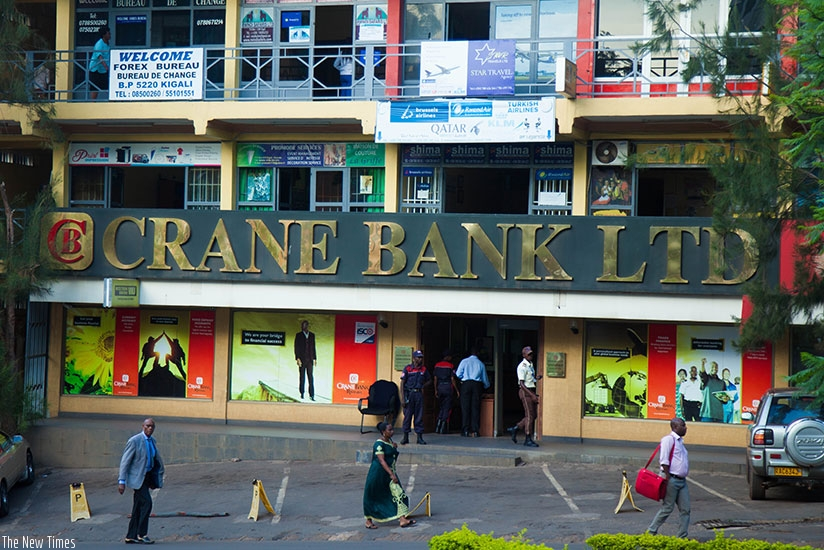Uganda’s commercial banks are increasingly turning away borrowers, a latest report from the Bank of Uganda (BoU) reveals.
According to BoU’s Monetary Policy Report for June 2017, growth in Private Sector Credit (PSC) remains subdued, despite the easing of the Central Bank Rate (CBR), a benchmark lending rate for commercial banks, for over a year.
The BoU has since April 2016 been easing the monetary policy so much that it’s now at 10%, but banks have remained cautious towards lending.
“Modest PSC growth despite sustained monetary easing in part highlights supply-side constraints,” BoU says, adding that demand for credit as witnessed by loan applications remains robust while supply (loan approvals) remains subdued.
“There is significant disparity between value of loan applications and approvals especially for the Manufacturing and Building, construction & real estate sectors,” BoU says.
The report reveals that annual growth in PSC averaged 6.5% in the quarter to April 2017 as in the quarter to Jan’17, but lower than 9.5% in the quartet to April 2016.
There has been negative credit growth in manufacturing, building & services sectors, while positive growth has been registered in Agriculture, Trade and Personal loans (54% share).
Consequently, Uganda Bureau of Statistics (UBOS) indicates that there was lower growth in all sectors in 2016/17. Agriculture is expected to grow at 1.3%, Industry at 3.4% and Services at 5.1% from respective values of 2.8%, 4.7% and 5.9% in 2015/16.
According to latest statistics from BoU, total commercial banks lending to the private sector stood at Shs11.43trn in April 2017, down from Shs11.51trn in January 2017.
In the same month last year (2016), total commercial banks lending to the private sector stood at Shs10.7trn. This implies that for almost a year or so, PSC has remained subdued.
However, Non-Performing Loans (NPLs) as a ratio of total loans declined to 6.3% in March 2017 from 10.5% in December 2016.
The report nonetheless adds that NPLs could further increase as there are “higher loans in watchful category.”
Why Banks Are Cautious
According to figures obtained by Business Focus, total industry NPLs (excluding Stanbic) increased to Shs557.8bn in 2016, up from Shs515.6bn in 2015.
The banking sector has recorded unprecedented NPLs in recent years, a thing that has put the sector on the spot.
It is worth noting that the collapse of Crane Bank, one of the three big banks then, was largely due to high NPLs that increased by 122.9% to Shs142.3bn in 2015, up from Shs19.36bn in 2014.This saw the once profitable bank post a whooping loss of Shs3.1bn in 2015, down from a net profit of Shs50.6bn in 2014.
On October 20, 2016, the Bank of Uganda (BoU), the regulator of Uganda’s financial sector, took over the management of Crane Bank Ltd after it (Crane Bank) became “a significantly undercapitalized institution.” Consequently, on February 27, 2017, BoU announced the acquisition of the now defunct Crane Bank by dfcu.
This state of affairs has seen many banks become cautious towards lending. This explains why loans advanced to customers didn’t grow remarkably in 2016.
Overall, Uganda’s 24 banks advanced loans to customers worth Shs9.96trn in 2016, slightly up from Shs9.53trn in 2015.
In an exclusive interview, Wilbrod Owor, the Executive Director at Uganda Bankers Association told Business Focus that low loan approvals is beyond monetary easing and pricing factors.

He noted that the “appetite for lending is still low” given the history of arrears-many customers are still struggling to pay back their loans.
“The outlook [for the economy] isn’t yet encouraging. If I give a loan given the macro-economic environment, will the borrower make profit you give a loan?” Owor said, adding that banks assess the situation before approving loans.
He noted that the demand side is still low and this is compounded by lack of serious local content laws that has seen the biggest percentage of government benefit foreign contractors, a thing he said restraints lending locally.
Fabian Kasi, the Chairman of Uganda Bankers Association adds that banks normally extend credit to viable project which fit into their credit risk appetite.
“If banks perceive a likelihood of not paying back in time or at all, they will not extend all the credit applied for or any at all. Currently, the economy is reeling from a situation of slowness in activities in the economy. Non-Performing Loans have also been on a high side. This situation causes the banks to be cautious in extending credit,” Kasi, who is also the Managing Director at Centenary Bank, says.
Asked key things banks consider before approving a loan, Kasi said that they consider the cash flow potential of the project.
“They (Banks) also consider how well capitalized the project is, on top of the character of the owners of the project or business. Character may refer to willingness to pay back, as opposed to ability to pay back. If all these show positive indications, then banks will consider the collateral or security of the loan, just in case it is not paid back,” he said in an exclusive interview.
Bad For The Economy
In a country that is largely dependent on the private sector, low PSC growth spells doom for the economy.
“When private sector credit is not growing as well as it should, it is not good for the economy since businesses will not be able to access credit for investment and job creation,” Kasi says, adding: “There is need to stimulate the economy, breath some more life in it for more activities, and therefore demand, so that projects become attractive to private sector credit.”

He adds that there are four players responsible for boosting the economy. The central bank manages aggregate demand in the economy.
“The central bank may boost by reducing interest rates at which banks borrow from it. They may also leave more cash in the economy to be accessed by people for consumption and investment. All these actions however must be balanced, lest some other macro economic factors may go wrong, for example inflation, exchange rates etc,” he says.
He adds that government is another player with means to boost the economy.
“Government may spend more into the economy thereby boosting demand which would entice businesses to invest, and therefore borrow from banks. Government may also reduce the crowding out of the private sector by not borrowing much from the public, thereby leaving the banks with no option but to lend to private sector. Therefore the fiscal policies of government have a role to play in private sector lending,” he explains.
He adds that banks and other financial institutions can also play a big role in boosting the economy.
“Banks should reduce their costs of operations so that the savings are passed on as reduced interest rates thereby boosting private sector lending. Banks should also create very convenient lending products attractive to the private sector,” he says, adding the borrowing public is also a big player in boosting the economy.
“They should diligently borrow and ensure that they pay back the loans,” he says.
The Future
UBOS’ estimates of economic activity in 2016/17 indicate an annual growth rate of 3.9% lower than 4.7% in 2015/16. However, growth is projected to pick up at 5.0% in FY 2017/18 supported by improved efficiency and effectiveness in implementation of public investments, investments in the oil sector if implemented as planned, recovery in PSC growth as lending rates continue declining and favorable weather conditions to support the agricultural sector, says BoU.
“Downside risks to growth however remain and the growth of 5.0 percent may be hard to achieve. PSC may continue to be constrained given that commercial banks continue to tighten credit standards. Moreover, low credit to the manufacturing, business services and mortgage which are the main drivers of growth continue to decline,” BoU says.
Additionally, challenges to the agricultural sector remain especially the unpredictable weather patterns, low quality inputs – seeds, fertilizers and pesticides and low access to credit.
“Overall, the outlook is cloudy. Perpetual delays in implementation of public investments, with the performance of Government projects remaining unsatisfactory, combined with subdued PSC extension put significant constraint to growth outlook,” BoU says, adding: “Growth could therefore underperform the current projection of 5% in 2017/18. However, should investments in the oil sector proceed as planned; growth could pickup to an average of 6.3% in the medium-term.”






